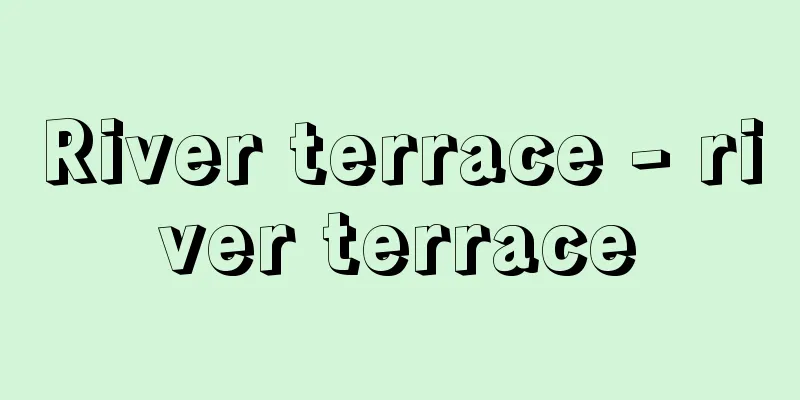River terrace - river terrace

|
A stepped landform along a river that is higher than the lowlands created by the river (riverbed, floodplain, valley bottom plain, alluvial fan, delta, etc.). The flat areas are called terrace surfaces, and the steep cliffs are called terrace cliffs. Lowlands created by rivers that have become terrace surfaces are specifically called fluvial terraces. In contrast, fluvial terraces that are created when lava flows, volcanic debris flows, or large-scale debris flows flow into the valley bottom and deposit there, or when the valley bottom is filled in by landslides or large landslides, are distinguished from fluvial terraces. When lowlands turn into terraces, this is called terrace formation. The causes differ depending on whether the river is a mountain river (mountain river) upstream or a flat river (flat river or alluvial river) downstream. In other words, in mountain rivers, when the amount of gravel supplied from the upstream mountains increases, the river's lateral erosion (side incision) becomes active, widening the valley bottom, and when the amount of gravel supplied decreases, the side incision weakens and only undercutting progresses, resulting in the former valley bottom becoming a terrace. In fact, during the cold period of the last glacial period several tens of thousands of years ago, the tree line height dropped and the amount of debris supplied from the mountain slopes increased, causing the valley bottom to widen and be filled in with thick gravel. The valley bottoms from that time remain in various places as sedimentary terraces consisting of thick layers of gravel several tens of meters thick. Then, throughout the postglacial period from about 20,000 years ago, undercutting progressed in an environment where the supply of gravel from the upstream mountains decreased, causing the wide valley floor to narrow gradually, eventually turning into a canyon. Several tiers of erosional terraces, each consisting of a relatively thin layer of gravel just a few meters thick, developed during this process. Compared to sedimentary terrace deposits, which contain large amounts of fine-grained gravel, erosional terrace deposits are characterized by being composed primarily of coarse residual gravel. Terraces formed in this way due to an increase or decrease in the supply of debris caused by climate change are called climatic terraces. Increases or decreases in the supply of debris can also occur due to large forest fires, earthquakes, volcanic activity, or large-scale landslides. Unlike mountain and rivers, the Hirakawa River undermined as sea levels dropped during the last glacial period, and several eroded terraces developed in the process. In the plains, where thick deposits of sediment were deposited due to the rise in sea levels in the postglacial period from about 20,000 years ago, the downstream parts of these low terraces have been filled in by alluvial deposits (Holocene strata) and are now buried below the alluvial surface. To understand the development of fluvial terraces, it is useful to observe a small stream of water flowing onto a sandy coast. You can see how several terraces are formed by the continuous lowering of the riverbed. [Hiroshi Ikeda] "River Terraces: A Geomorphological Study" by Machida Sada (1979, Kokin Shoin) [References] | | | | | | | | | | flow| | |Source: Shogakukan Encyclopedia Nipponica About Encyclopedia Nipponica Information | Legend |
|
河川に沿う階段状の地形で、河川のつくる低地(河床、氾濫原(はんらんげん)、谷底(こくてい)平野、扇状地、三角州など)よりも高い位置にあるもの。平坦(へいたん)な部分を段丘面、急崖(がい)を段丘崖とよぶ。河川がつくった低地が段丘面になったものをとくに河成段丘という。これに対して、溶岩流や火山砕屑(さいせつ)流や大規模な土石流などが流れ込んで谷底に堆積(たいせき)したり、地すべりや大きな山崩れによって谷底が埋積されたりしたために生じた河岸段丘は河成段丘とは区別される。 低地が段丘になることを段丘化という。その原因は上流の山川(やまかわ)(山地河川)と下流の平川(ひらかわ)(平地河川あるいは沖積河川)とで異なる。すなわち、山川では上流山地からの砂礫(れき)供給量の増大期に河川の側方侵食作用(側刻(そっこく)作用)が盛んになって谷底が拡幅し、砂礫供給量の減少期に側刻作用が弱まって下刻(かこく)のみが進行する結果、かつての谷底が段丘化する。実際には数万年前以降の最終氷期の寒冷期に、森林限界高度が低下して山地斜面からの岩屑(がんせつ)供給量が増大したために谷底は拡幅され、厚い砂礫に埋積された。当時の谷底が厚さ数十メートルといった厚い砂礫層からなる堆積段丘として各地に残されている。その後、2万年ほど前以降の後氷期を通じて、上流山地からの砂礫供給量が減少する環境下で下刻が進行し、幅の広かった谷底がしだいに狭くなり、ついには峡谷となった。厚さ数メートルという比較的薄い砂礫層からなる数段の侵食段丘がこの過程で発達した。細粒の砂礫を大量に含む堆積段丘堆積物と比較すると、侵食段丘堆積物は粗大な残留礫を主体とする点に特徴がある。このように気候変化に伴う岩屑供給量の増減によって生じた段丘を気候段丘とよぶ。岩屑供給量の増減はこのほか、大規模な山火事や地震、あるいは火山活動や大規模崩壊に伴っても生じる。 山川とは違って、平川では最終氷期の海面低下に伴って河川の下刻が進行し、その過程で数段の侵食段丘面が発達した。2万年ほど前以降の後氷期の海面上昇によって土砂が厚く堆積した平野では、これらの低い段丘面の下流部は沖積層(完新統=完新世の地層)に埋め立てられて沖積面下に埋没している。河成段丘の発達過程を理解するためには砂浜海岸に注ぐ小さな水流を観察するとよい。連続的な河床低下によって数段の段丘面が形成されるようすを見ることができる。 [池田 宏] 『町田貞著『河岸段丘 その地形学的研究』(1979・古今書院)』 [参照項目] | | | | | | | | | | | | | | |出典 小学館 日本大百科全書(ニッポニカ)日本大百科全書(ニッポニカ)について 情報 | 凡例 |
Recommend
Takanao Kikuchi
Year of birth: Year of birth and death unknown. A ...
Karamizakura - Karamizakura
…Suminomizakura is used as an ingredient in proce...
Magnetograph
The term "solar magnetograph" is used to...
Javanese - Javanese (English spelling)
The main ethnic group on the Indonesian island of ...
mille-feuille (English spelling) millefeuille
...Add the flour and mix lightly, then transfer t...
Umbilical cord prolapse
This refers to the rupture of the amniotic membran...
Instigator - Kyosahan
A form of complicity, especially in the narrow se...
Home economics book - Kaseisho
… In 17th-century Western Europe, small families ...
Sleepiness - Sleepiness
Please see our page on Narcolepsy. Source: Encycl...
Nakamura Tokizo
A Kabuki actor. The stage name was Harimaya for t...
Mirror [Village] - Kagami
A village in Tosa County in central Kochi Prefectu...
Sharatchandra (English spelling)
1876‐1938 A representative novelist of Bengali lit...
Allomyces arbuscula (English spelling) Allomycesarbuscula
…[Tsubaki Keisuke]. . . *Some of the terminology ...
Vieussens, R.
…During the Edo period, diseases accompanied by c...
Etruscans - Etruriajin (English spelling) Etrusci (Latin)
In the first millennium BC, they were a people wh...









